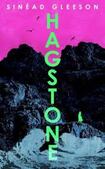
Hagstones have long fascinated writers and artists; many magical powers and stories have been attributed to them since before the time of Pliny the Elder. It is believed that these perforated stones were made by serpents’ saliva. Only good things can pass through the holes; they are supposed to bring luck. There is something similarly magical and otherworldly about Sinéad Gleeson’s debut novel Hagstone, successor to her acclaimed collection of essays, Constellations.
Nell is an artist on a rugged, isolated island, with an almost spiritual connection to the land; she draws inspiration from the sea, the shore, the folklore. She dreams of worlds past and present and craves a future where she is not tied to this land that has always been her home. She has many ideas and concepts that she is afraid to put into practice, some because of her own reticence or lack of self-belief and some because of a lack of funding and support. Most artists would relate to this, the desperate yearning to create something meaningful.
There is an eerie sound on the island that only some can hear. It is perhaps the sea and the land calling out to the people whose souls are entrenched deeply there. Nell receives an invitation to enter a secluded community of women, the Inions, to create an artwork to commemorate their lives. These are women who have escaped something or someone, creating a model of collaborative, self-sustained living. It sounds appealing, this idea to disconnect, to live away from external gaze. Nell resists becoming part of such a community, only seeing herself as an outsider, but finds slowly that perhaps they have much more in common than she imagined.
The story starts languorously and then picks up pace after part one. The main characters are beautifully fleshed out, especially that of Nell and the women in the Inion community. But some minor characters, such as the American actor searching for his next project who persuades the Inions to take part in a documentary, veer precariously towards stereotype. A frenzied momentum leads up to the Samhain festival, when everything comes to a climax, people’s weaknesses and foibles are exposed, and then there is loss and a fresh start.
READ MORE
An island, cut off from the mainland, is a perfect setting for a haunting story such as this, where ancient rituals and beliefs can fester and thrive, where people can find solace in solitude, but also healing and recuperation. At times it felt that Nell and the island were one, a contiguous sense of wildness and restraint, hardness and softness nudging each other, both sensuous and ascetic at the extremities.
What does creativity need and desire? How to be a woman in this world? Can power be all-consuming? There are so many intricate threads wound together with Nell and the Inions, but the island and the sea are the main characters, sensuously pulsating with mystery on every page. There is a lyricism to the short, punchy sentences interwoven with folklore. A deep sense of intimacy which connects the reader to the people, their lives and their connection to the land.
The strength of the novel lies in the intense claustrophobia and spatial expansiveness that Gleeson’s exquisite writing can evoke at the same time. The descriptions are detailed and poetic, the story is both inward looking into the lives of the Inions and Nell, while also outward looking, constantly drawing from science, art and contemporary media.
Gleeson is an intelligent writer, drawing on a deep knowledge of art and artists. I loved her descriptions of various artworks, the way these are folded in with the story itself. There are threads of what solitude means for creativity, and what connection and community can be good for, and how it can threaten the very thing that it strives and stands for.
You can smell the sea and the cooking, breathe the heady air and the smell of the candles, feel the salt on your tongue. It is a sensory explosion, a throbbing hankering for something bigger than what we believe we deserve in life. The ending was a bit dissatisfying, but perhaps it is an authentic one. Things don’t close as neatly in life as in books, they always have holes you have to look through to see the world more clearly. And hopefully we will only see magic as in a hagstone.













